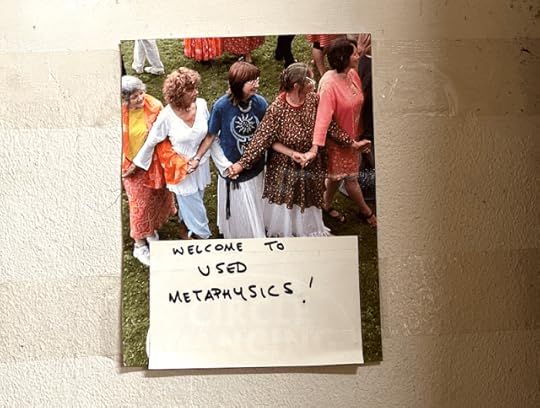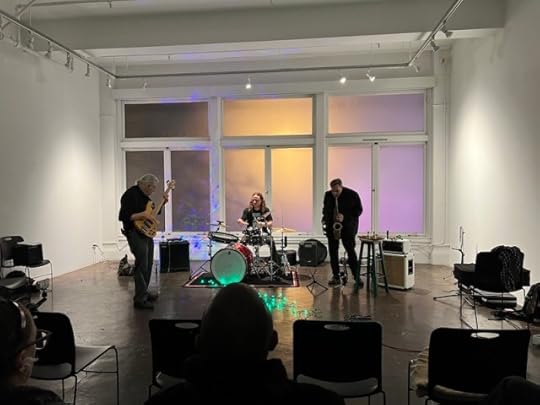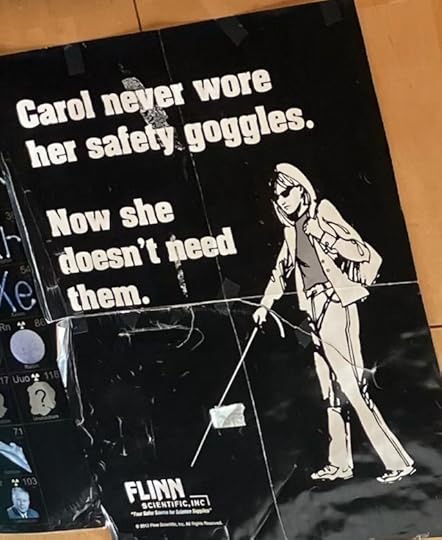Marc Weidenbaum's Blog, page 36
December 23, 2024
December 22, 2024
Used Metaphysics

The local bookstore has many great signs on its walls. I don’t think I’d noticed this one previously.
December 21, 2024
Scratch Pad: Chainsaw, Overload, LitRPG
At the end of each week, I usually collate a lightly edited collection of recent comments I’ve made on social media, which I think of as my public scratch pad. I find knowing I’ll revisit my posts to be a positive and mellowing influence on my social media activity. I mostly hang out on Mastodon (at post.lurk.org/@disquiet), and I’m also trying out a few others. And I generally take weekends off social media. In fact, currently I’m off social media entirely (and I’m off a lot of other digital social venues, as well, including several Slacks, several email discussion lists, several Discourses, etc.), and that will remain the case until the first week or so of January. So, what follows are some notes I made for myself — a digital social network of one, though occasionally people do reply to posts I write — from the past week:
▰ The sound of chainsaws becomes immediately commonplace following the close call with a tornado
▰ There’s a new Steven Soderbergh–directed movie coming, titled Black Bag, starring Michael Fassbender in yet another spy role (following, recently, The Killer and The Agency), alongside Cate Blanchett. No composer is, at the moment, listed on IMDB, but Thomas Newman was reportedly associated with the project along the way.
▰ Had dinner at a Thai restaurant where I’m fairly certain the house stereo played just the same two Christmas songs on repeat the entire time.
▰ The practicalities of courtship in 1817: “the fact is, I want a reader for my evenings; but I am fastidious in voices, and I cannot endure listening to an imperfect reader.” I started reading George Eliot’s Middlemarch. If I understand this early passage correctly, a gentleman, Mr. Casaubon, is saying he is looking for a wife who will read to him when his eyes are tired. Now that is early audiobook culture. One of the sisters involved in this scene, only a few pages earlier, said taking care of the blind John Milton would have been a calling. So who knows what’s to come? Also, this is the third novel I’ve read this year that mentions Adam Smith’s Wealth of Nations early on (the others being Babel: Or the Necessity of Violence: An Arcane History of the Oxford Translators’ Revolution and The Thousand Autumns of Jacob de Zoet), the main difference being that at the time when Eliot wrote Middlemarch, Smith’s book’s publication was still a somewhat recent memory.
▰ Someday I’ll remember that Command+Option+Esc is the Mac’s Ctrl+Alt+Delete. Someday.
▰ Filed a 500-word article. You know how these things go: it would have taken me half as long had it been 1,000 words.
▰ The artist Hannes Pasqualini and I now have the first two of our four-panel comics complete, and we’ll begin rolling them out later this month (beginning on December 30th), with subsequent ones at a fairly regular cadence in the coming year. We did a half dozen of these during the first year of the pandemic.
▰ We had an earthquake, a tsunami alert, and a tornado alert, plus intense wind and rain, over the past couple weeks. I’d like a chill rest of the year. I’ve pretty much logged off of work until January 6.
▰ I hurt my left wrist 12 weeks ago yesterday, and I still can’t comfortably play guitar, but I’ve been using my synths a lot, and fortunately typing is fine.
▰ I think the only way through the onslaught of information and chaos in our the world is to make something of your own over a long period of time. That is the through line; that is where balance is found. You can’t just absorb; you perhaps should also produce. This proposal isn’t about becoming part of the problem; it’s about processing as a means of managing.
▰ My search data on this website inform me that a number of people have come here this week and searched for the title of the new Aphex Twin compilation, Music from the Merch Desk (2016 – 2023), which makes sense, since I wrote a book 10 years ago for Bloomsbury’s 33 1/3 series about Selected Ambient Works Volume II. I don’t have much to say about Music from the Merch Desk at the moment. We’ll see where my ears take me. I will say this: I’ve just never been the sort of music critic who has an opinion about everything. If I don’t write about something, it doesn’t mean I don’t like it; it just means I feel I have nothing in particular to add. So much writing doesn’t add anything. I may weigh in at some point, but trigger-finger urgency is part of what’s wrong with the modern internet: hot takes, cursory judgement, filler, fodder, SEO optimization. AI isn’t the only entity on the planet that creates slop.
▰ It would be the most natural thing for me to start a record label, but it just seems like a lot of work to merely contribute another drop in the ocean, and in turn to undertake a vast amount of uninteresting promotional activity as a requisite to achieve the pleasure of sharing good work by people I admire, and to do right by them. Unless there was really a “different” way for me to go about it, something I think about regularly, I don’t think I’d do it. In many ways, the Disquiet Junto is that record label: weekly compilation albums that anyone can join in. Still …
▰ So far I’ve finished reading 29 novels this year, and that number doesn’t include getting well into War and Peace and Life: A User’s Manual before, respectively, pausing and stopping, and less far into many other books I won’t name. This week I finished reading two novels: Survival Quest, in the LitRPG genre (which is new to me), by Vasily Mahanenko, and Case Histories, by Kate Atkinson. Reading Survival Quest is a bit like playing an RPG campaign with a stellar DM and some highly experienced other players; they are top of their game, and you’re more along for an enjoyable ride. Considering I started reading it just out of curiosity, and fairly certain I wouldn’t enjoy it, I had a great time. Case Histories I’m not so sure about: so many characters, a lot of moments evocatively told, but perhaps so many that they become easily confused, and so many incidents and confessions and so forth, so much emotion right at the surface, but then so many significant events that just pass right by. That much emotion can feel like a meal that is all dessert, which for some people may sound excellent, but for me is a lot to take in.
December 20, 2024
Data Overload, 1817 Edition

That is from Middlemarch, George Eliot’s novel, back in 1817. This will either be the last novel I finish reading in 2024 or one of the first I finish reading in 2025.
December 19, 2024
Disquiet Junto Project 0677: Jeux d’enfants

Each Thursday in the Disquiet Junto music community, a new compositional challenge is set before the group’s members, who then have five days to record and upload a track in response to the project instructions.
Membership in the Junto is open: just join and participate. (A SoundCloud account is helpful but not required.) There’s no pressure to do every project. The Junto is weekly so that you know it’s there, every Thursday through Monday, when your time and interest align.
Tracks are added to the SoundCloud playlist for the duration of the project. Additional (non-SoundCloud) tracks also generally appear in the lllllll.co discussion thread.
Disquiet Junto Project 0677: Jeux d’enfants
The Assignment: Make music inspired by a children’s toy or game.
Step 1: In the early 1870s, the composer George Bizet wrote a suite of short pieces, each inspired by one or another toy or game beloved by children. The first in the series, “L’escarpolette,” suggested a swing, and another, “La toupie,” a spinning top. There were pieces for soap bubbles and leap-frog, as well. Read up on and listen to Bizet’s suite, which was titled Jeux d’enfants, or Children’s Games.
Step 2: Choose a suitable toy or game, perhaps one from your own childhood, or perhaps something even more modern.
Step 3: Record a short piece of music inspired by the subject you selected in Step 2.
Tasks Upon Completion:
Label: Include “disquiet0677” (no spaces/quotes) in the name of your track.
Upload: Post your track to a public account (SoundCloud preferred but by no means required). It’s best to focus on one track, but if you post more than one, clarify which is the “main” rendition.
Share: Post your track and a description/explanation at https://llllllll.co/t/disquiet-junto-project-0677-jeux-denfants/
Discuss: Listen to and comment on the other tracks.
Additional Details:
Length: The length is up to you. How long does your top spin?
Deadline: Monday, December 23, 2024, 11:59pm (that is: just before midnight) wherever you are.
About: https://disquiet.com/junto/
Newsletter: https://juntoletter.disquiet.com/
License: It’s preferred (but not required) to set your track as downloadable and allowing for attributed remixing (i.e., an attribution Creative Commons license).
Please Include When Posting Your Track:
More on the 677th weekly Disquiet Junto project, Jeux d’enfants — The Assignment: Make music inspired by a children’s toy or game — at https://disquiet.com/0677/
December 18, 2024
Final Night(s) at the Luggage Store

I don’t know if tonight was the final night of the Luggage Store Gallery Music Series, which Rent Romus has run or co-run for the past 22 of its 30 years. I think there’s one more concert, on January 8, but if I understood correctly, there may not be, something about a possible cancellation, but I may have misunderstood. In any case, if tonight was the last night, it was a great one to go out on. Two bands, both trios, a musician shared between them, first on guitar as the leader, then as the youngest member of a group in which he played the drums. That would be Inkwells Trio (Lorenzo Arreguin, guitar; Elijah Pontecorvo, six-string fretless bass; Christian Arriola, drums) followed by saxophonist Romus’ long-running (since 1995) group with a shifting lineup, Lords of Outland (tonight: him; Ray Scheaffer, five-string bass; Arreguin, drums). Both bands played out, the Inkwells a loud jazz metal, with Arreguin calling out directions with a combination of cards and hand signals, and Outland a keening, spirited free jazz. The gallery building, here in San Francisco, on Market Street, around the corner from 6th Street, is due to be sold.


And the city smiled for its close-up on my way home:

December 17, 2024
Robin Fox’s Lasers

Did I mention* I attended one night of the Recombinant Media Labs festival this month? There were lasers, courtesy of Robin Fox, as part of Triptych, a tribute to Polish audio-visual artist Stanislaus Ostoja-Kotkowski. The accompanying sharp, somehow sparse yet tightly packed techno was not just perfectly aligned with the ever-shifting images; it was so exhilarating that I found myself closing my eyes just to listen, which was sort of exactly the opposite of the concept, but so be it. A great night at Gray Area, courtesy of impresario Naut Humon.

*Ah, I did.
December 16, 2024
Music Thing Workshop (KOMA Chameleon)
A quick lunchtime experiment. The Music Thing Workshop System (the device here dressed in black) does, indeed, supply sufficient power to run the KOMA Elektronik Field Kit (the device here dressed in white), which means I can easily run the randomly sampled FM radio from the latter into the modulated filter in the former. I imagine someone will recognize some of what is being sampled in realtime, but I certainly can’t. I wrote a story for The Wire magazine a few years ago about musical instruments that contain radios, and during the research phase I learned from KOMA that the radio portion of the Field Kit might someday become a standalone module, and that happened recently (though just the FM reception, not the AM or shortwave). Anyhow, much exploring ahead.
December 15, 2024
Emergency Handsets

Emergency Handsets would have been a great name for a new wave band. And it comes with its own snaky logo.
December 14, 2024
Scratch Pad: Tornado Alert
At the end of each week, I usually collate a lightly edited collection of recent comments I’ve made on social media, which I think of as my public scratch pad. I find knowing I’ll revisit my posts to be a positive and mellowing influence on my social media activity. I mostly hang out on Mastodon (at post.lurk.org/@disquiet), and I’m also trying out a few others. And I generally take weekends off social media. In fact, currently I’m off social media entirely (and I’m off a lot of other digital social venues, as well, including several Slacks, several email discussion lists, several Discourses, etc.), and that will remain the case until the first week or so of January. So, what follows are some notes I made for myself — a digital social network of one, though occasionally people do reply to posts I write — from the past week:
▰ White noise apps on your laptop have their own volume control because you want to keep the system sound low, so you don’t have your earbuds blasted with an alert.
▰ While I collate my social media activity in these weekly Scratch Pad posts, I don’t by any means collect here much of what I am up to on forums and BBS’s and so forth. But I do on occasion, and one thing I wanna track is my interest in izzzzi.net, so here’s on the Lines forum about izzzzi and its potential. The discussion about izzzzi is private currently, so I’m careful here not to expose anything, not that there’s anything untoward about the discussion as a whole:
I really dig izzzzi, and I dig it both as a self-contained community and as something more akin to a protocol that is agnostic of specific communities. I think about people in different communities (like a set of friends or a subset of family or people collaborating on a project) using it as a way to, just within their own little unit, share things with each other — almost (not certainly, but possibly) to the point where it would be beneficial to have a different identity for each subset, so as to actively keep them separate from each other.
Perhaps down the road, there might even be a way to collate one’s follows into subsets that yield different daily izzzzi “today” pages, but that may be too many complications. (Though, it would also be a way to politely follow someone without, you know, seeing their stuff all the time. Less a mute than a shutter you can open and close.)
I’m into the network complexity that results from the collision of simple and frictional. That’s izzzzi. And it’s too bad I’m still on this social media hiatus right now, ’cause it includes izzzzi (but not Lines, for me). But it’s cool. I can watch izzzzi mature from the sidelines.
▰ I tend to wake early on Saturdays, some lizard brain from my childhood eagerly awaiting cartoons. So, I was up for a couple minutes before the actual tornado (!) alert — see below — went off this morning at around 5:50am. This is in San Francisco, mind you. I was actually reflecting at that moment on how barely a week ago we got the tsunami alert, right after the earthquake, for which I received no advance alert. Here’s evidence of the tornado alert:

▰ In some countries it is illegal for a phone camera app to not make a sound.
▰ This completes my third full week of an ongoing social media break, with about three more weeks remaining, and it’s been good so far. It took about two weeks to chill the part of my brain that is actively noting things to note, which is to say noting things to note things publicly. I wrote a lot this week, but I jotted down fewer of the little observations that have formed the majority of my social media output. Which means my brain is breaking that habit. I would say that for me, a two-week social media break is the minimum. For the first week, it’s not really a break, per se. The second week is when the chill begins, and the third is when the chill has taken hold, when the chill is the new room temperature.




